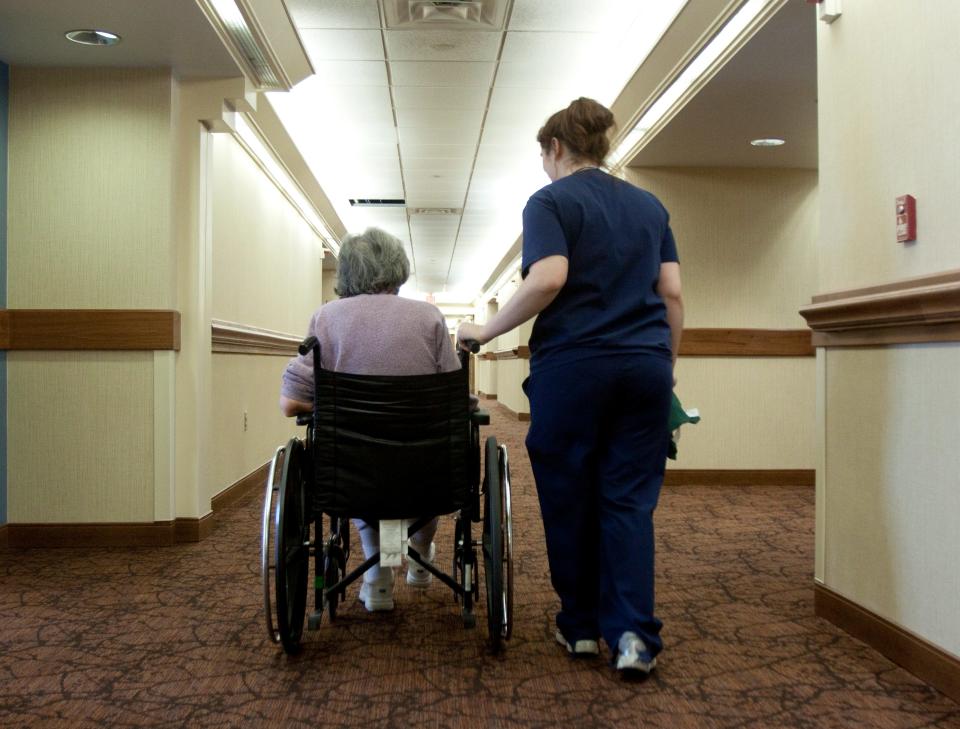Which nursing homes meet new federal staffing standards? See data for your local facility.
Nearly all nursing homes in America will have to hire more nurses and aides under a new rule released this week that mandates a minimum level of staffing, although the gap is significantly wider in many Southern states.
Just 160 skilled nursing facilities out of roughly 14,500 that receive federal payments for care met the new requirements every day last summer, according to the most recent daily time card data available to the public and analyzed by USA TODAY. Most nursing homes met core components of the new rule on only three days out of 92 in the quarter.
About half the time, facilities had enough people to provide each resident at least 0.55 hours of care from a registered nurse (RN) each day, as the new rules require. About one day each week, the facilities could provide each resident 2.45 hours of care from a certified nursing assistant (CNA, or aide), which they must do every day under the new rules. In addition, nursing homes have to provide a total of at least 3.45 hours per resident of daily nurse-and-aide staffing as well as have a registered nurse on site 24/7.
Map: Do nursing homes near you meet the new standards?
The map below shows federally funded skilled nursing facilities and how short, on average, they were from meeting the requirement for at least 3.45 hours of daily nurse-and-aide care, based on a USA TODAY analysis of the summer 2023 quarter. Blue dots indicate facilities that met the standard more often than not. Don’t see a nursing home map? Click here.
The USA TODAY analysis found that many facilities comply with some components of the rule at least part of the time, but it is rare for them to consistently meet all the minimums.
It was more common for nursing homes to have enough registered nurses, with most meeting the minimum about half the time. It was less common for facilities to have enough aides on duty, with most only having enough CNAs about one-third of the time.
The rules will be phased in over three years. The regulation also allows an exemption to the rules for facilities that can prove they are located in an area with a shortage of health-care workers and have made a good faith effort to hire more nurses and aides.
Why is it important to have enough nurses and aides staffing a nursing home?
For decades, academic research has shown that staffing levels reliably predict the quality of care in nursing homes and that shortages increase the risk of delayed response to daily needs, like toileting and eating, as well as medical emergencies, such as falls and strokes. A pivotal federal study from 20 years ago, when most nursing home residents were younger and healthier than today, suggested a minimum of 4.1 hours per resident each day – more than the new rule.

These are the first nationwide minimum staffing rules with numeric benchmarks, which supporters have said will make it easier to track and enforce.
Regulations have long required – and still do – that skilled nursing facilities have enough nurses and aides with the correct training to meet the needs of every resident’s care plan. Some people require more care from a registered nurse for complex medical conditions. Others need more assistance from an aide with daily tasks like getting out of bed or eating. A previous USA TODAY investigation found, however, that the rule was rarely enforced.
Service Employees International Union (SEIU), a union representing many health care professions, had advocated for the new staffing minimums as crucial to reducing burnout and turnover among nurses and aides in addition to the benefits for the residents they serve. The new rule could result in nursing homes hiring more than 200,000 additional care workers – if they can find them.
Which states have the biggest gap in nursing home staffing compared to the new rules?
It is more common in several Southern states for skilled nursing facilities to operate with fewer nurses and aides than the new rule would require.
In Louisiana, nursing homes had, on average, the total minimum staffing on just 3 out of 92 days in the summer quarter last year. The next lowest were Texas (4 days), Oklahoma (8), Tennessee (8) and Georgia (9).
Louisiana, Oklahoma and Texas had the biggest gap to fill on registered nurse staffing, meeting the new requirement on 6 days, 14 days and 16 days out of 92. In addition to Puerto Rico, Guam and Washington, D.C., three states, on average, had facilities meeting the new standard at least 75 days in the quarter: Alaska (90), Hawaii (88), Utah (79), Maine (76) and Delaware (75).
Many Southern states also fared poorly when comparing current staffing of aides to the new requirements. Out of 92 days, facilities met the CNA requirement on 11 days in Texas, 15 days in Tennessee and 16 days in Virginia. On the flip side, facilities, on average, met the requirement on 89 days in Alaska, 81 days in Oregon and 72 days in North Dakota.
This article originally appeared on USA TODAY: Which nursing homes have enough nurses to meet new staffing minimum?


